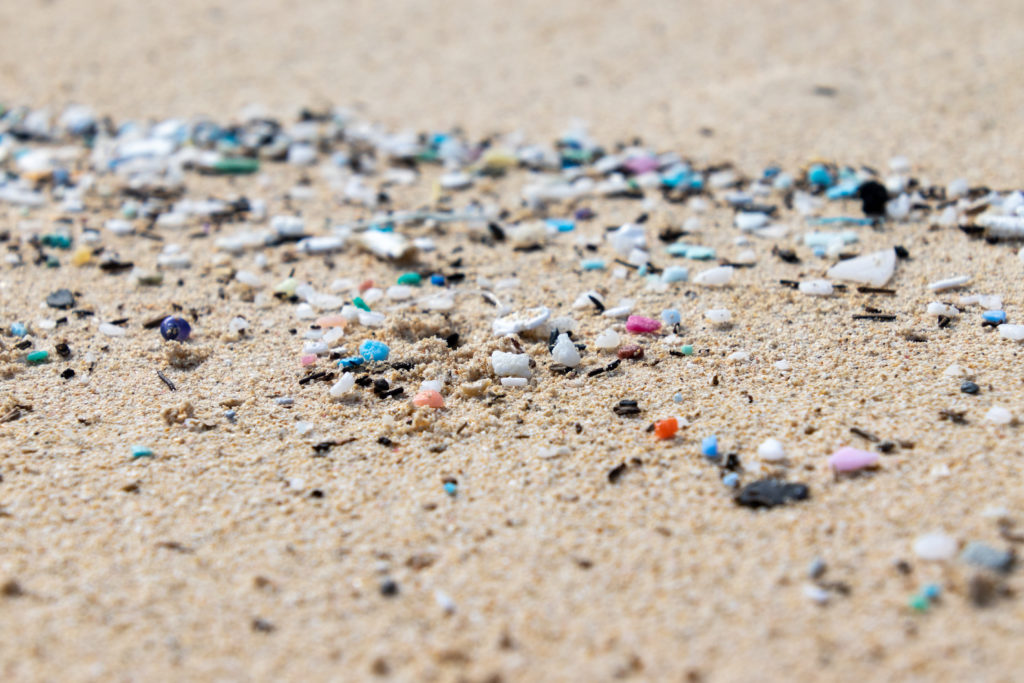Recently there has been a growing awareness about a type of pollution called microplastics. These plastic particles have been discovered everywhere from Arctic snow to Spanish sea salt, and consumers are rightly concerned about how microplastics affect humans and whether or not they are toxic.
Yet despite their ubiquity, there is still much we don’t understand about microplastics, and little has been done to reduce its existence. To provide some clarity, we’ve summarized what there is to know about the major microplastic problem.
What are microplastics?
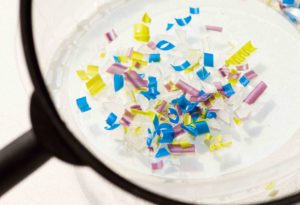 As the name suggests, microplastics are tiny pieces of plastic that range in size from 5mm in diameter to 1 micrometer—often too small to be seen with the naked eye. Beyond those tiny pieces of microplastic, there are also microscopic particles of plastic known as nanoplastics that range in size from 1 micrometer to 1 nanometer, which is similar to the size of a strand of DNA.
As the name suggests, microplastics are tiny pieces of plastic that range in size from 5mm in diameter to 1 micrometer—often too small to be seen with the naked eye. Beyond those tiny pieces of microplastic, there are also microscopic particles of plastic known as nanoplastics that range in size from 1 micrometer to 1 nanometer, which is similar to the size of a strand of DNA.
Microplastics are created in two different ways for which there are two different categories: primary and secondary. Primary microplastics are those that were already less than 5mm before they entered the environment—essentially pieces of plastic that were manufactured to be tiny, for use as things like microfibers and microbeads.
Secondary microplastics are those that have been shed by larger pieces of plastic debris, like fishing nets and soda bottles, after they entered the environment. These larger plastic objects break down gradually due to physical impact or natural weathering processes, resulting in the formation of micro and nanoplastics.
The rise of microplastics
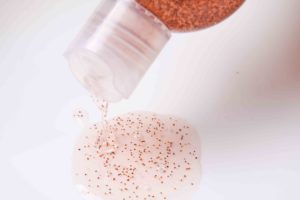 While secondary microplastics end up in the environment when larger pieces of plastic break down, primary microplastics were manufactured to be tiny, and are found in items we use every day. The exfoliating beads that have been used in face and body care products are primary microplastics, and the fibers of synthetic materials like nylon and acrylic, which form a large part of wardrobes, are also made from plastic.
While secondary microplastics end up in the environment when larger pieces of plastic break down, primary microplastics were manufactured to be tiny, and are found in items we use every day. The exfoliating beads that have been used in face and body care products are primary microplastics, and the fibers of synthetic materials like nylon and acrylic, which form a large part of wardrobes, are also made from plastic.
The glitter used in kids’ crafts and decorations is another often-overlooked microplastic, and many types of tea bags are made from microplastics. These primary microplastics typically end up in the environment through our water supply when glitter or microbeads are rinsed down the drain or in our laundry.
Another major source of large primary microplastics is plastic resin pellets called “nurdles”, which are commonly manufactured for use in the production of larger plastic products. Microplastics are also utilized as industrial abrasives to remove rust and paint and even form blades of the synthetic grass used on some sports fields.
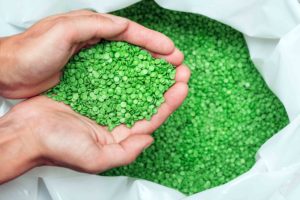 Microplastics have presumably existed for about as long as we’ve used plastic, but became more prevalent in the natural environment as our production and consumption of the material increased during the latter half of the 20th century. As early as the 1960s scientists began to report discovering tiny pieces of plastic trapped inside sea birds’ stomachs and in plankton nets.
Microplastics have presumably existed for about as long as we’ve used plastic, but became more prevalent in the natural environment as our production and consumption of the material increased during the latter half of the 20th century. As early as the 1960s scientists began to report discovering tiny pieces of plastic trapped inside sea birds’ stomachs and in plankton nets.
Microplastics were truly discovered and defined in the early 2000s when scientists researching marine pollution began focusing specifically on plastic particles that were nearly too small to view with the naked eye. Alarm about this new form of pollution grew, but it wasn’t until the early 2010s when corporations and the general public became aware of the issues surrounding microplastics.
How microplastics affect humans
What exactly are the issues? Initial research into microplastics has been based on what was found on the surface of the ocean and washed up on beaches. But recently scientists have begun searching deeper and have discovered it in the depths of the ocean, and inside our own bodies.
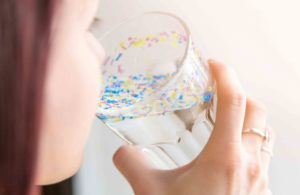 We consume microplastics with our food and drink them in our water and by some estimates, we are consuming as much as a credit card’s worth of plastic each week. Perhaps most shockingly, there’s not much we can do about it: neither municipal water treatment facilities nor consumer products like store-bought filters can successfully remove 100% of the microplastics in drinking water. Recent studies have even shown that there are also microplastics in the air that could enter our lungs when we breathe.
We consume microplastics with our food and drink them in our water and by some estimates, we are consuming as much as a credit card’s worth of plastic each week. Perhaps most shockingly, there’s not much we can do about it: neither municipal water treatment facilities nor consumer products like store-bought filters can successfully remove 100% of the microplastics in drinking water. Recent studies have even shown that there are also microplastics in the air that could enter our lungs when we breathe.
It’s generally believed at this point that microplastics aren’t harmful to our bodies in current concentrations, but nobody is really sure what the long-term effects might be. A report by the World Health Organization pointed out that, while the body is likely to flush out larger microplastics naturally, smaller microplastics can penetrate organs and get trapped inside the body. The report casts doubts on whether they have the potential to build up in harmful quantities but admits that is still insufficient research to know what the effects could be for certain. Nanoplastics are an even greater mystery and more research needs to be done.
It’s also difficult to say how microplastics affect humans because there are a wide variety of plastics made from many different substances. While some chemicals may be safe for humans up to certain limits, others have been shown to be carcinogens or endocrine disruptors that affect hormone production and are linked to infertility, immunity, and neurological issues.
How microplastics affect marine life
Microplastic pollution was first discovered on beaches and on the surface of bodies of water and it is here in aquatic environments where there is the most cause for alarm.
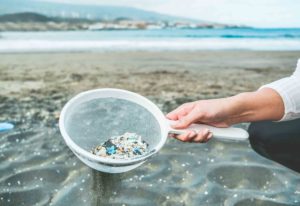 Near the surface and on land, microplastics have been discovered in sea birds, aquatic mammals, and even fish larvae. Particularly devastating “nurdle spills”, which occur when cargo containers are cast-off ships in storms, result in billions of plastic particles entering the environment. The nurdles float on the surface or wash ashore on beaches, where they are both intentionally and unintentionally consumed by animals like fish, turtles, and birds.
Near the surface and on land, microplastics have been discovered in sea birds, aquatic mammals, and even fish larvae. Particularly devastating “nurdle spills”, which occur when cargo containers are cast-off ships in storms, result in billions of plastic particles entering the environment. The nurdles float on the surface or wash ashore on beaches, where they are both intentionally and unintentionally consumed by animals like fish, turtles, and birds.
In recent years, the focus has shifted to deeper regions of the ocean, which is home to a plethora of life that we have still yet to fully discover and understand. The results so far have been troubling: studies have now shown that there are significantly more microplastic particles deep in the ocean than we thought, and even more than what is closer to the surface.
One study by Monterey Bay Aquarium in California revealed that there were about four times as many microplastic particles in the midwater—180 to 460 meters deep—than there were on the surface of the ocean. And rather than being from plastic waste related to fishing, like abandoned nets, the majority of particles were made of the same material as single-use food and beverage containers.
Unlike the effects on humans, the detrimental impact of microplastics on marine life is more evident. Microplastics have been shown to block the digestive tract, stunt growth, and lead to decreased fertility, amongst other health and behavioral issues, in a variety of species. And because we are at the top of the food chain, the microplastics that end up in marine life end up in us.
This in turn is potentially more harmful than when we consume microplastics directly, as research has shown that microplastics absorb heavy metals like lead along with other toxic chemicals while they are submerged in marine environments.
Are microplastics illegal?
 Widespread awareness of the dangers microplastics pose to wildlife and the unknown effects they have on our bodies has led to a succession of selective bans in countries around the world. Microbeads grabbed headlines when they were first banned by the Netherlands in 2014 then by the US in 2015, and a number of countries have followed suit. An EU-wide ban is in the works on microplastics added to some products but has been criticized for conversely promoting nanoplastics in its place.
Widespread awareness of the dangers microplastics pose to wildlife and the unknown effects they have on our bodies has led to a succession of selective bans in countries around the world. Microbeads grabbed headlines when they were first banned by the Netherlands in 2014 then by the US in 2015, and a number of countries have followed suit. An EU-wide ban is in the works on microplastics added to some products but has been criticized for conversely promoting nanoplastics in its place.
Overall, there is a general lack of legislation in place that aims to reduce the number of microplastics that enter the environment. And banning microplastics only addresses part of the problem, as secondary microplastics will still inevitably be created by plastics that are improperly disposed of and enter the environment.
Microplastics and recycling
The most important action both businesses and consumers can take to reduce microplastic pollution is to minimize their use of plastic. In recent years there has been significant movement worldwide to ditch single-use plastics, explore sustainable alternatives, and even go zero waste. But at the moment, our relationship with plastic is more complicated than that. Many plastics do serve important purposes that further food safety, technology, and human health. And despite the rise of sustainability movements, the production of plastic is set to continue rising into the near future, which means we need short-term solutions to the problem of microplastics.
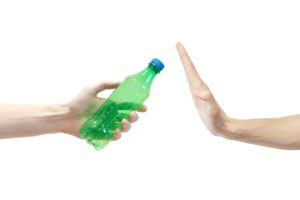 This is exactly why responsible waste management and recycling is vital. We need to divert as much plastic as possible from landfill and ensure it’s delivered to facilities that can handle and process it in a way that prevents accidental leakage into the environment. Recycling also needs to be easier, understandable, and more widespread, with products and packaging designed with the circular economy in mind. While there are currently no solutions to dealing with the microplastics and nanoplastics that already exist, these steps would, at the very least, prevent a significant amount of new plastic from polluting the environment.
This is exactly why responsible waste management and recycling is vital. We need to divert as much plastic as possible from landfill and ensure it’s delivered to facilities that can handle and process it in a way that prevents accidental leakage into the environment. Recycling also needs to be easier, understandable, and more widespread, with products and packaging designed with the circular economy in mind. While there are currently no solutions to dealing with the microplastics and nanoplastics that already exist, these steps would, at the very least, prevent a significant amount of new plastic from polluting the environment.
In the long term, as technology advances, we can hope that an efficient method will be developed to capture and recycle microplastics, but for now, reducing use and recycling are the most effective things we can do to control this pervasive and still little-understood form of pollution.
For more information on sustainable materials, waste reduction, and recycling, subscribe to our blog. Or speak with one of our TRUE Waste Advisors to learn how to improve waste and recycling practices in your business.

